Analysis of Business Finance: Performance and Strategies
VerifiedAdded on 2023/01/06
|13
|3654
|29
Report
AI Summary
This comprehensive report analyzes the financial performance of a business, focusing on key areas such as statement of profit or loss, statement of financial position, and ratio analysis. It delves into the understanding of financial information, contrasting accrual and cash accounting methods, and explaining the significance of profit versus cash flow. The report further examines budgeting processes and their purpose within an organization. Through detailed analysis of financial ratios like current ratio, quick ratio, gross profit margin, and debt-to-equity ratio, the report provides insights into the company's liquidity, profitability, and solvency. The report also covers efficiency ratios like asset turnover and inventory turnover, offering a holistic view of the business's financial health and operational effectiveness. The analysis includes practical examples and case studies, offering valuable insights for students and professionals in the field of finance. The report concludes with an assessment of the overall financial position of the company and proposes corrective actions.
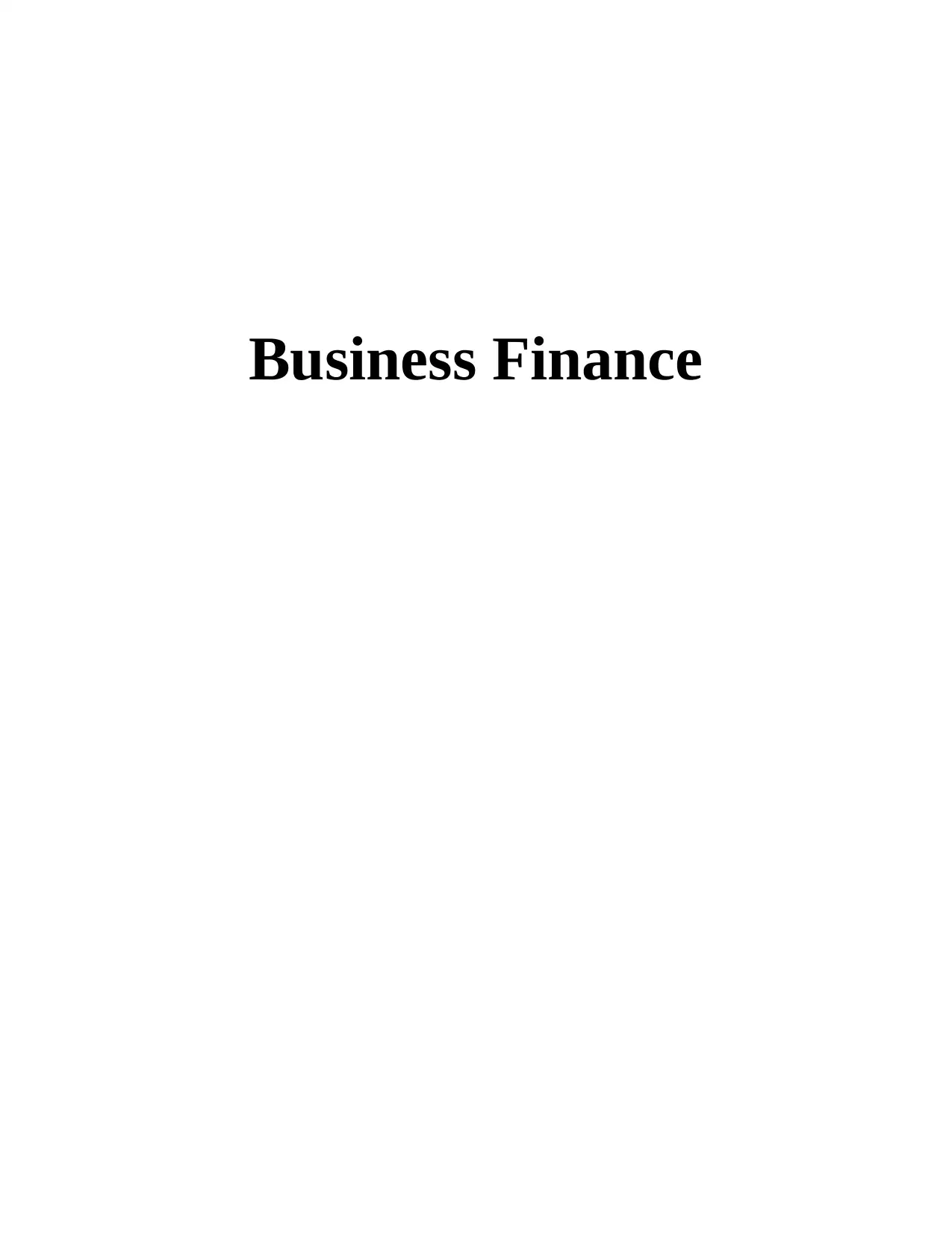
Business Finance
Paraphrase This Document
Need a fresh take? Get an instant paraphrase of this document with our AI Paraphraser
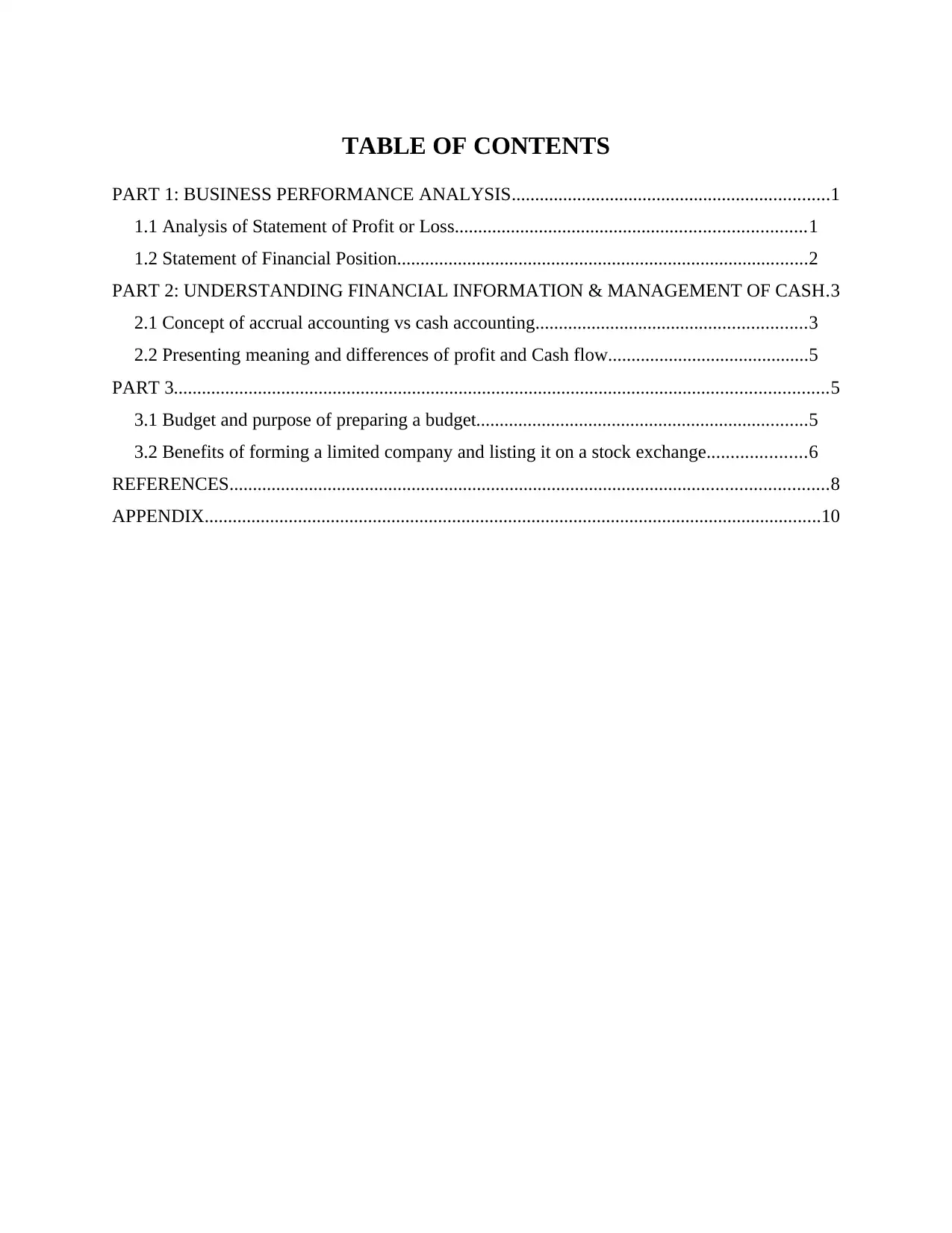
TABLE OF CONTENTS
PART 1: BUSINESS PERFORMANCE ANALYSIS....................................................................1
1.1 Analysis of Statement of Profit or Loss...........................................................................1
1.2 Statement of Financial Position........................................................................................2
PART 2: UNDERSTANDING FINANCIAL INFORMATION & MANAGEMENT OF CASH.3
2.1 Concept of accrual accounting vs cash accounting..........................................................3
2.2 Presenting meaning and differences of profit and Cash flow...........................................5
PART 3............................................................................................................................................5
3.1 Budget and purpose of preparing a budget.......................................................................5
3.2 Benefits of forming a limited company and listing it on a stock exchange.....................6
REFERENCES................................................................................................................................8
APPENDIX....................................................................................................................................10
PART 1: BUSINESS PERFORMANCE ANALYSIS....................................................................1
1.1 Analysis of Statement of Profit or Loss...........................................................................1
1.2 Statement of Financial Position........................................................................................2
PART 2: UNDERSTANDING FINANCIAL INFORMATION & MANAGEMENT OF CASH.3
2.1 Concept of accrual accounting vs cash accounting..........................................................3
2.2 Presenting meaning and differences of profit and Cash flow...........................................5
PART 3............................................................................................................................................5
3.1 Budget and purpose of preparing a budget.......................................................................5
3.2 Benefits of forming a limited company and listing it on a stock exchange.....................6
REFERENCES................................................................................................................................8
APPENDIX....................................................................................................................................10
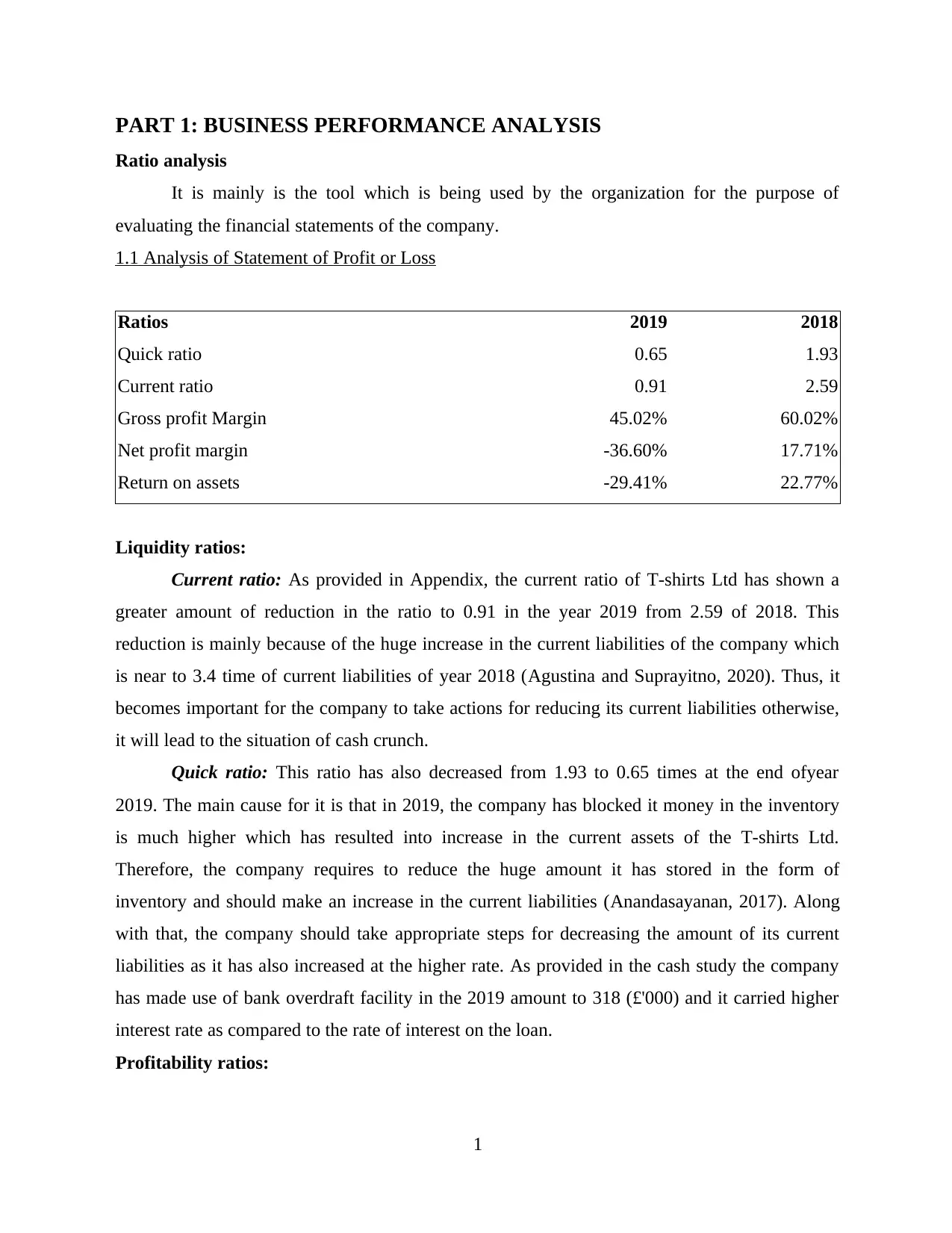
PART 1: BUSINESS PERFORMANCE ANALYSIS
Ratio analysis
It is mainly is the tool which is being used by the organization for the purpose of
evaluating the financial statements of the company.
1.1 Analysis of Statement of Profit or Loss
Ratios 2019 2018
Quick ratio 0.65 1.93
Current ratio 0.91 2.59
Gross profit Margin 45.02% 60.02%
Net profit margin -36.60% 17.71%
Return on assets -29.41% 22.77%
Liquidity ratios:
Current ratio: As provided in Appendix, the current ratio of T-shirts Ltd has shown a
greater amount of reduction in the ratio to 0.91 in the year 2019 from 2.59 of 2018. This
reduction is mainly because of the huge increase in the current liabilities of the company which
is near to 3.4 time of current liabilities of year 2018 (Agustina and Suprayitno, 2020). Thus, it
becomes important for the company to take actions for reducing its current liabilities otherwise,
it will lead to the situation of cash crunch.
Quick ratio: This ratio has also decreased from 1.93 to 0.65 times at the end ofyear
2019. The main cause for it is that in 2019, the company has blocked it money in the inventory
is much higher which has resulted into increase in the current assets of the T-shirts Ltd.
Therefore, the company requires to reduce the huge amount it has stored in the form of
inventory and should make an increase in the current liabilities (Anandasayanan, 2017). Along
with that, the company should take appropriate steps for decreasing the amount of its current
liabilities as it has also increased at the higher rate. As provided in the cash study the company
has made use of bank overdraft facility in the 2019 amount to 318 (£'000) and it carried higher
interest rate as compared to the rate of interest on the loan.
Profitability ratios:
1
Ratio analysis
It is mainly is the tool which is being used by the organization for the purpose of
evaluating the financial statements of the company.
1.1 Analysis of Statement of Profit or Loss
Ratios 2019 2018
Quick ratio 0.65 1.93
Current ratio 0.91 2.59
Gross profit Margin 45.02% 60.02%
Net profit margin -36.60% 17.71%
Return on assets -29.41% 22.77%
Liquidity ratios:
Current ratio: As provided in Appendix, the current ratio of T-shirts Ltd has shown a
greater amount of reduction in the ratio to 0.91 in the year 2019 from 2.59 of 2018. This
reduction is mainly because of the huge increase in the current liabilities of the company which
is near to 3.4 time of current liabilities of year 2018 (Agustina and Suprayitno, 2020). Thus, it
becomes important for the company to take actions for reducing its current liabilities otherwise,
it will lead to the situation of cash crunch.
Quick ratio: This ratio has also decreased from 1.93 to 0.65 times at the end ofyear
2019. The main cause for it is that in 2019, the company has blocked it money in the inventory
is much higher which has resulted into increase in the current assets of the T-shirts Ltd.
Therefore, the company requires to reduce the huge amount it has stored in the form of
inventory and should make an increase in the current liabilities (Anandasayanan, 2017). Along
with that, the company should take appropriate steps for decreasing the amount of its current
liabilities as it has also increased at the higher rate. As provided in the cash study the company
has made use of bank overdraft facility in the 2019 amount to 318 (£'000) and it carried higher
interest rate as compared to the rate of interest on the loan.
Profitability ratios:
1
⊘ This is a preview!⊘
Do you want full access?
Subscribe today to unlock all pages.

Trusted by 1+ million students worldwide
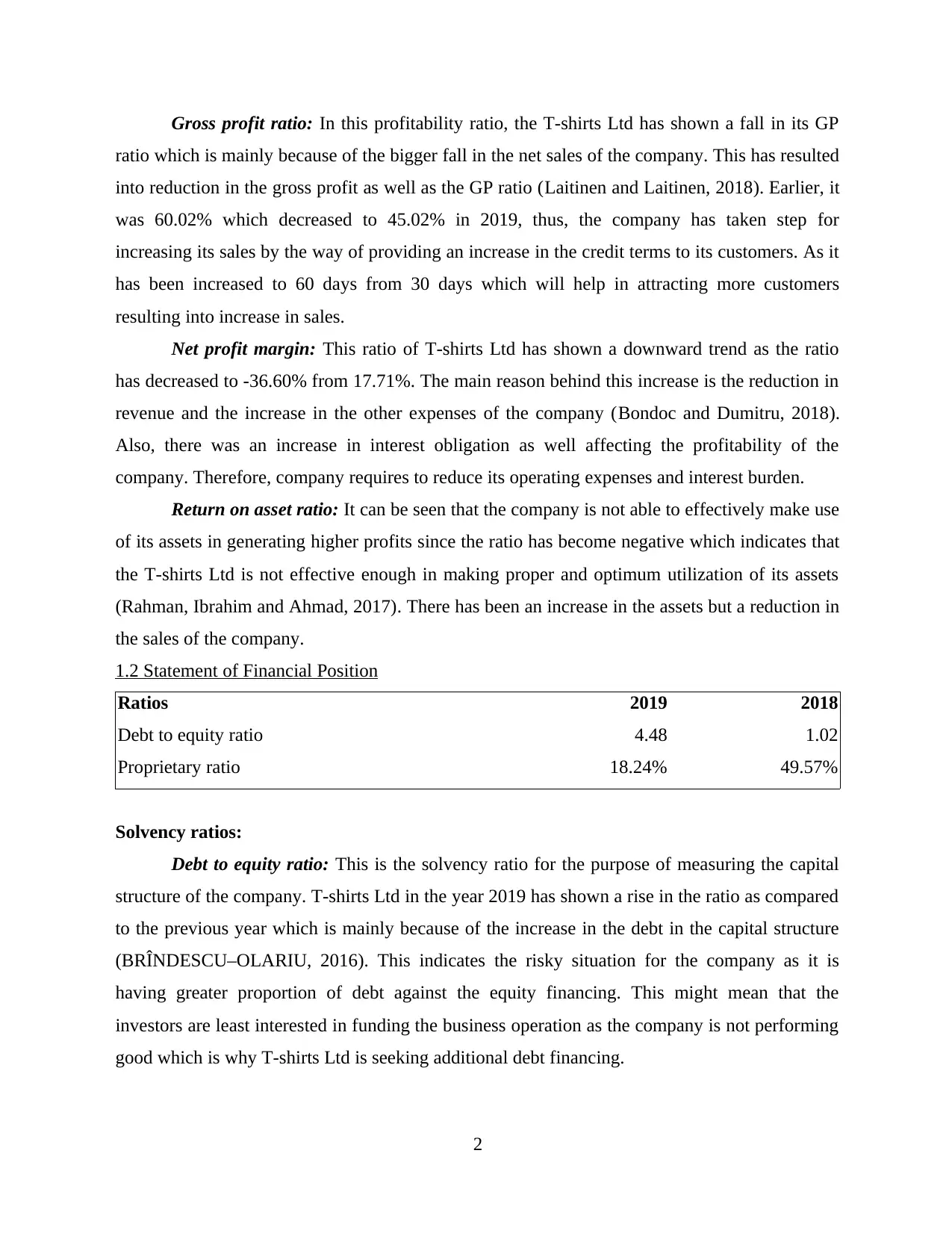
Gross profit ratio: In this profitability ratio, the T-shirts Ltd has shown a fall in its GP
ratio which is mainly because of the bigger fall in the net sales of the company. This has resulted
into reduction in the gross profit as well as the GP ratio (Laitinen and Laitinen, 2018). Earlier, it
was 60.02% which decreased to 45.02% in 2019, thus, the company has taken step for
increasing its sales by the way of providing an increase in the credit terms to its customers. As it
has been increased to 60 days from 30 days which will help in attracting more customers
resulting into increase in sales.
Net profit margin: This ratio of T-shirts Ltd has shown a downward trend as the ratio
has decreased to -36.60% from 17.71%. The main reason behind this increase is the reduction in
revenue and the increase in the other expenses of the company (Bondoc and Dumitru, 2018).
Also, there was an increase in interest obligation as well affecting the profitability of the
company. Therefore, company requires to reduce its operating expenses and interest burden.
Return on asset ratio: It can be seen that the company is not able to effectively make use
of its assets in generating higher profits since the ratio has become negative which indicates that
the T-shirts Ltd is not effective enough in making proper and optimum utilization of its assets
(Rahman, Ibrahim and Ahmad, 2017). There has been an increase in the assets but a reduction in
the sales of the company.
1.2 Statement of Financial Position
Ratios 2019 2018
Debt to equity ratio 4.48 1.02
Proprietary ratio 18.24% 49.57%
Solvency ratios:
Debt to equity ratio: This is the solvency ratio for the purpose of measuring the capital
structure of the company. T-shirts Ltd in the year 2019 has shown a rise in the ratio as compared
to the previous year which is mainly because of the increase in the debt in the capital structure
(BRÎNDESCU–OLARIU, 2016). This indicates the risky situation for the company as it is
having greater proportion of debt against the equity financing. This might mean that the
investors are least interested in funding the business operation as the company is not performing
good which is why T-shirts Ltd is seeking additional debt financing.
2
ratio which is mainly because of the bigger fall in the net sales of the company. This has resulted
into reduction in the gross profit as well as the GP ratio (Laitinen and Laitinen, 2018). Earlier, it
was 60.02% which decreased to 45.02% in 2019, thus, the company has taken step for
increasing its sales by the way of providing an increase in the credit terms to its customers. As it
has been increased to 60 days from 30 days which will help in attracting more customers
resulting into increase in sales.
Net profit margin: This ratio of T-shirts Ltd has shown a downward trend as the ratio
has decreased to -36.60% from 17.71%. The main reason behind this increase is the reduction in
revenue and the increase in the other expenses of the company (Bondoc and Dumitru, 2018).
Also, there was an increase in interest obligation as well affecting the profitability of the
company. Therefore, company requires to reduce its operating expenses and interest burden.
Return on asset ratio: It can be seen that the company is not able to effectively make use
of its assets in generating higher profits since the ratio has become negative which indicates that
the T-shirts Ltd is not effective enough in making proper and optimum utilization of its assets
(Rahman, Ibrahim and Ahmad, 2017). There has been an increase in the assets but a reduction in
the sales of the company.
1.2 Statement of Financial Position
Ratios 2019 2018
Debt to equity ratio 4.48 1.02
Proprietary ratio 18.24% 49.57%
Solvency ratios:
Debt to equity ratio: This is the solvency ratio for the purpose of measuring the capital
structure of the company. T-shirts Ltd in the year 2019 has shown a rise in the ratio as compared
to the previous year which is mainly because of the increase in the debt in the capital structure
(BRÎNDESCU–OLARIU, 2016). This indicates the risky situation for the company as it is
having greater proportion of debt against the equity financing. This might mean that the
investors are least interested in funding the business operation as the company is not performing
good which is why T-shirts Ltd is seeking additional debt financing.
2
Paraphrase This Document
Need a fresh take? Get an instant paraphrase of this document with our AI Paraphraser
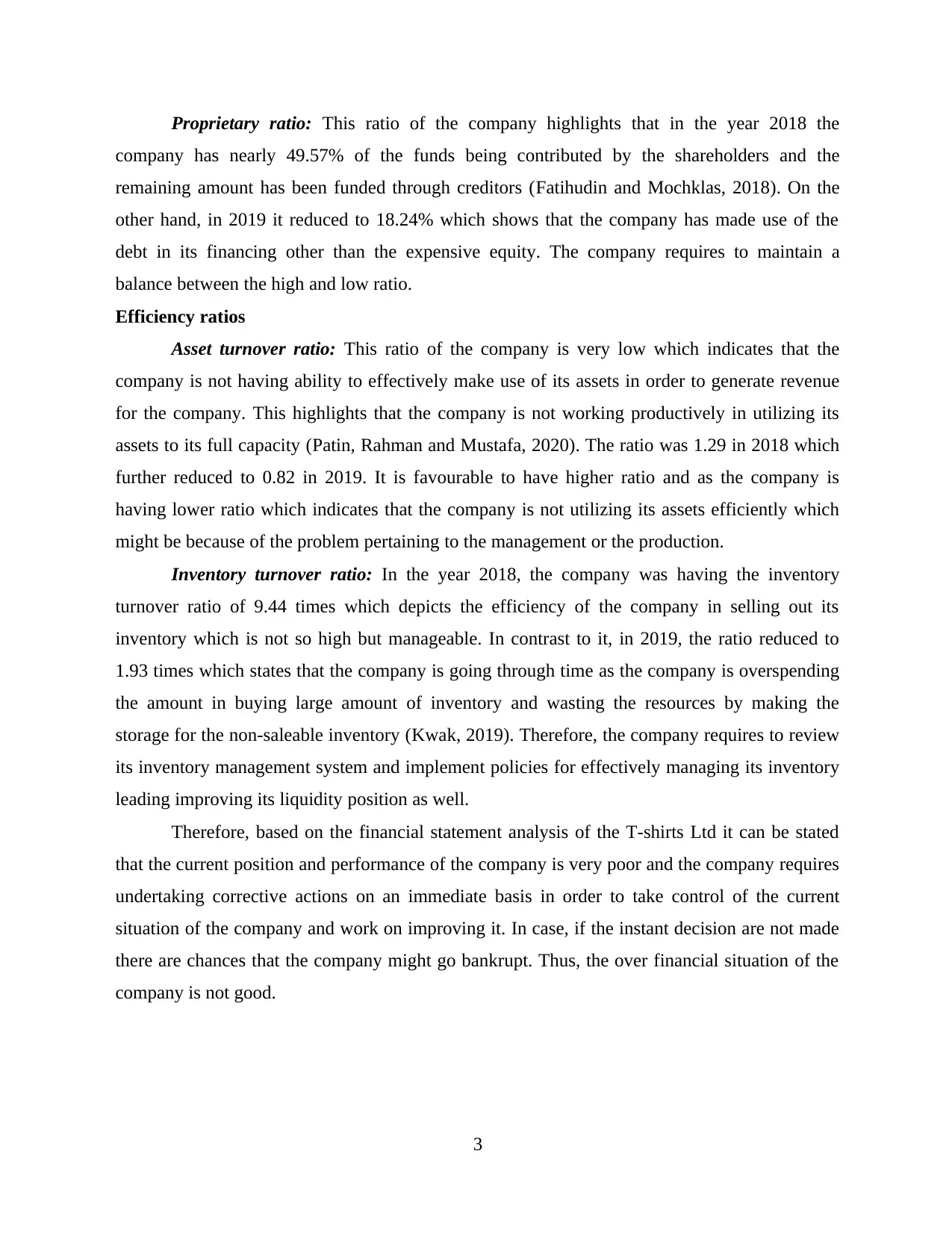
Proprietary ratio: This ratio of the company highlights that in the year 2018 the
company has nearly 49.57% of the funds being contributed by the shareholders and the
remaining amount has been funded through creditors (Fatihudin and Mochklas, 2018). On the
other hand, in 2019 it reduced to 18.24% which shows that the company has made use of the
debt in its financing other than the expensive equity. The company requires to maintain a
balance between the high and low ratio.
Efficiency ratios
Asset turnover ratio: This ratio of the company is very low which indicates that the
company is not having ability to effectively make use of its assets in order to generate revenue
for the company. This highlights that the company is not working productively in utilizing its
assets to its full capacity (Patin, Rahman and Mustafa, 2020). The ratio was 1.29 in 2018 which
further reduced to 0.82 in 2019. It is favourable to have higher ratio and as the company is
having lower ratio which indicates that the company is not utilizing its assets efficiently which
might be because of the problem pertaining to the management or the production.
Inventory turnover ratio: In the year 2018, the company was having the inventory
turnover ratio of 9.44 times which depicts the efficiency of the company in selling out its
inventory which is not so high but manageable. In contrast to it, in 2019, the ratio reduced to
1.93 times which states that the company is going through time as the company is overspending
the amount in buying large amount of inventory and wasting the resources by making the
storage for the non-saleable inventory (Kwak, 2019). Therefore, the company requires to review
its inventory management system and implement policies for effectively managing its inventory
leading improving its liquidity position as well.
Therefore, based on the financial statement analysis of the T-shirts Ltd it can be stated
that the current position and performance of the company is very poor and the company requires
undertaking corrective actions on an immediate basis in order to take control of the current
situation of the company and work on improving it. In case, if the instant decision are not made
there are chances that the company might go bankrupt. Thus, the over financial situation of the
company is not good.
3
company has nearly 49.57% of the funds being contributed by the shareholders and the
remaining amount has been funded through creditors (Fatihudin and Mochklas, 2018). On the
other hand, in 2019 it reduced to 18.24% which shows that the company has made use of the
debt in its financing other than the expensive equity. The company requires to maintain a
balance between the high and low ratio.
Efficiency ratios
Asset turnover ratio: This ratio of the company is very low which indicates that the
company is not having ability to effectively make use of its assets in order to generate revenue
for the company. This highlights that the company is not working productively in utilizing its
assets to its full capacity (Patin, Rahman and Mustafa, 2020). The ratio was 1.29 in 2018 which
further reduced to 0.82 in 2019. It is favourable to have higher ratio and as the company is
having lower ratio which indicates that the company is not utilizing its assets efficiently which
might be because of the problem pertaining to the management or the production.
Inventory turnover ratio: In the year 2018, the company was having the inventory
turnover ratio of 9.44 times which depicts the efficiency of the company in selling out its
inventory which is not so high but manageable. In contrast to it, in 2019, the ratio reduced to
1.93 times which states that the company is going through time as the company is overspending
the amount in buying large amount of inventory and wasting the resources by making the
storage for the non-saleable inventory (Kwak, 2019). Therefore, the company requires to review
its inventory management system and implement policies for effectively managing its inventory
leading improving its liquidity position as well.
Therefore, based on the financial statement analysis of the T-shirts Ltd it can be stated
that the current position and performance of the company is very poor and the company requires
undertaking corrective actions on an immediate basis in order to take control of the current
situation of the company and work on improving it. In case, if the instant decision are not made
there are chances that the company might go bankrupt. Thus, the over financial situation of the
company is not good.
3
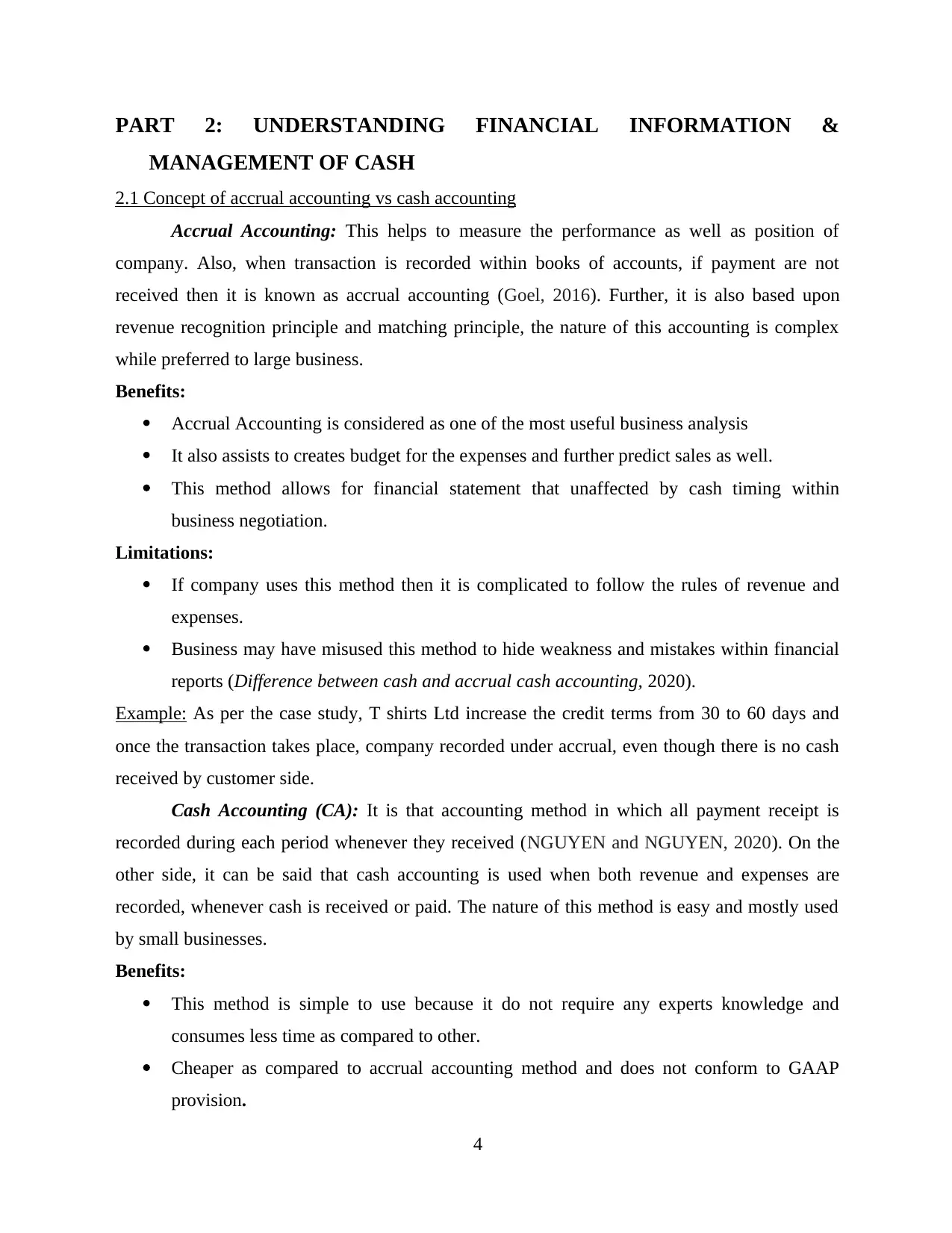
PART 2: UNDERSTANDING FINANCIAL INFORMATION &
MANAGEMENT OF CASH
2.1 Concept of accrual accounting vs cash accounting
Accrual Accounting: This helps to measure the performance as well as position of
company. Also, when transaction is recorded within books of accounts, if payment are not
received then it is known as accrual accounting (Goel, 2016). Further, it is also based upon
revenue recognition principle and matching principle, the nature of this accounting is complex
while preferred to large business.
Benefits:
Accrual Accounting is considered as one of the most useful business analysis
It also assists to creates budget for the expenses and further predict sales as well.
This method allows for financial statement that unaffected by cash timing within
business negotiation.
Limitations:
If company uses this method then it is complicated to follow the rules of revenue and
expenses.
Business may have misused this method to hide weakness and mistakes within financial
reports (Difference between cash and accrual cash accounting, 2020).
Example: As per the case study, T shirts Ltd increase the credit terms from 30 to 60 days and
once the transaction takes place, company recorded under accrual, even though there is no cash
received by customer side.
Cash Accounting (CA): It is that accounting method in which all payment receipt is
recorded during each period whenever they received (NGUYEN and NGUYEN, 2020). On the
other side, it can be said that cash accounting is used when both revenue and expenses are
recorded, whenever cash is received or paid. The nature of this method is easy and mostly used
by small businesses.
Benefits:
This method is simple to use because it do not require any experts knowledge and
consumes less time as compared to other.
Cheaper as compared to accrual accounting method and does not conform to GAAP
provision.
4
MANAGEMENT OF CASH
2.1 Concept of accrual accounting vs cash accounting
Accrual Accounting: This helps to measure the performance as well as position of
company. Also, when transaction is recorded within books of accounts, if payment are not
received then it is known as accrual accounting (Goel, 2016). Further, it is also based upon
revenue recognition principle and matching principle, the nature of this accounting is complex
while preferred to large business.
Benefits:
Accrual Accounting is considered as one of the most useful business analysis
It also assists to creates budget for the expenses and further predict sales as well.
This method allows for financial statement that unaffected by cash timing within
business negotiation.
Limitations:
If company uses this method then it is complicated to follow the rules of revenue and
expenses.
Business may have misused this method to hide weakness and mistakes within financial
reports (Difference between cash and accrual cash accounting, 2020).
Example: As per the case study, T shirts Ltd increase the credit terms from 30 to 60 days and
once the transaction takes place, company recorded under accrual, even though there is no cash
received by customer side.
Cash Accounting (CA): It is that accounting method in which all payment receipt is
recorded during each period whenever they received (NGUYEN and NGUYEN, 2020). On the
other side, it can be said that cash accounting is used when both revenue and expenses are
recorded, whenever cash is received or paid. The nature of this method is easy and mostly used
by small businesses.
Benefits:
This method is simple to use because it do not require any experts knowledge and
consumes less time as compared to other.
Cheaper as compared to accrual accounting method and does not conform to GAAP
provision.
4
⊘ This is a preview!⊘
Do you want full access?
Subscribe today to unlock all pages.

Trusted by 1+ million students worldwide
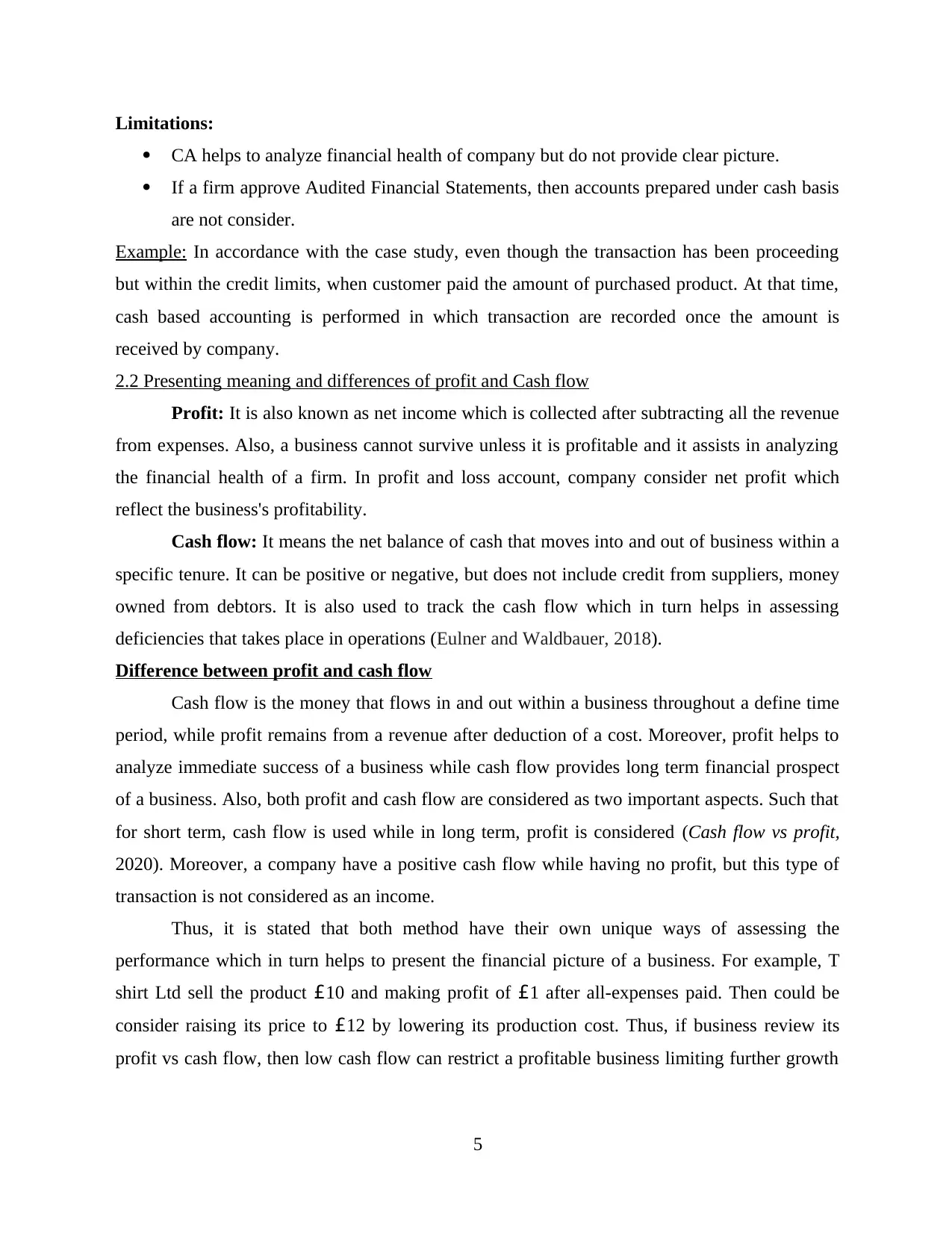
Limitations:
CA helps to analyze financial health of company but do not provide clear picture.
If a firm approve Audited Financial Statements, then accounts prepared under cash basis
are not consider.
Example: In accordance with the case study, even though the transaction has been proceeding
but within the credit limits, when customer paid the amount of purchased product. At that time,
cash based accounting is performed in which transaction are recorded once the amount is
received by company.
2.2 Presenting meaning and differences of profit and Cash flow
Profit: It is also known as net income which is collected after subtracting all the revenue
from expenses. Also, a business cannot survive unless it is profitable and it assists in analyzing
the financial health of a firm. In profit and loss account, company consider net profit which
reflect the business's profitability.
Cash flow: It means the net balance of cash that moves into and out of business within a
specific tenure. It can be positive or negative, but does not include credit from suppliers, money
owned from debtors. It is also used to track the cash flow which in turn helps in assessing
deficiencies that takes place in operations (Eulner and Waldbauer, 2018).
Difference between profit and cash flow
Cash flow is the money that flows in and out within a business throughout a define time
period, while profit remains from a revenue after deduction of a cost. Moreover, profit helps to
analyze immediate success of a business while cash flow provides long term financial prospect
of a business. Also, both profit and cash flow are considered as two important aspects. Such that
for short term, cash flow is used while in long term, profit is considered (Cash flow vs profit,
2020). Moreover, a company have a positive cash flow while having no profit, but this type of
transaction is not considered as an income.
Thus, it is stated that both method have their own unique ways of assessing the
performance which in turn helps to present the financial picture of a business. For example, T
shirt Ltd sell the product £10 and making profit of £1 after all-expenses paid. Then could be
consider raising its price to £12 by lowering its production cost. Thus, if business review its
profit vs cash flow, then low cash flow can restrict a profitable business limiting further growth
5
CA helps to analyze financial health of company but do not provide clear picture.
If a firm approve Audited Financial Statements, then accounts prepared under cash basis
are not consider.
Example: In accordance with the case study, even though the transaction has been proceeding
but within the credit limits, when customer paid the amount of purchased product. At that time,
cash based accounting is performed in which transaction are recorded once the amount is
received by company.
2.2 Presenting meaning and differences of profit and Cash flow
Profit: It is also known as net income which is collected after subtracting all the revenue
from expenses. Also, a business cannot survive unless it is profitable and it assists in analyzing
the financial health of a firm. In profit and loss account, company consider net profit which
reflect the business's profitability.
Cash flow: It means the net balance of cash that moves into and out of business within a
specific tenure. It can be positive or negative, but does not include credit from suppliers, money
owned from debtors. It is also used to track the cash flow which in turn helps in assessing
deficiencies that takes place in operations (Eulner and Waldbauer, 2018).
Difference between profit and cash flow
Cash flow is the money that flows in and out within a business throughout a define time
period, while profit remains from a revenue after deduction of a cost. Moreover, profit helps to
analyze immediate success of a business while cash flow provides long term financial prospect
of a business. Also, both profit and cash flow are considered as two important aspects. Such that
for short term, cash flow is used while in long term, profit is considered (Cash flow vs profit,
2020). Moreover, a company have a positive cash flow while having no profit, but this type of
transaction is not considered as an income.
Thus, it is stated that both method have their own unique ways of assessing the
performance which in turn helps to present the financial picture of a business. For example, T
shirt Ltd sell the product £10 and making profit of £1 after all-expenses paid. Then could be
consider raising its price to £12 by lowering its production cost. Thus, if business review its
profit vs cash flow, then low cash flow can restrict a profitable business limiting further growth
5
Paraphrase This Document
Need a fresh take? Get an instant paraphrase of this document with our AI Paraphraser
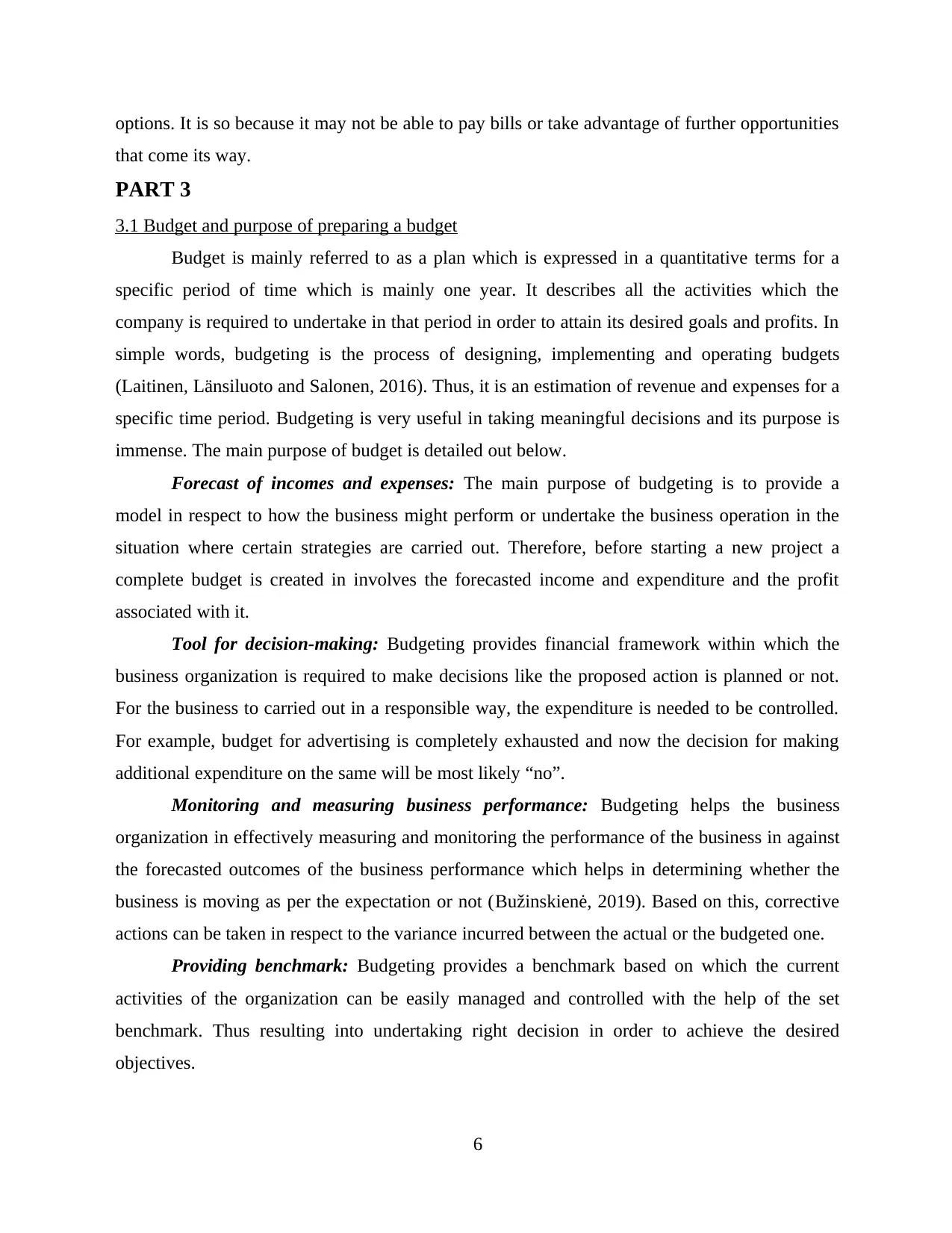
options. It is so because it may not be able to pay bills or take advantage of further opportunities
that come its way.
PART 3
3.1 Budget and purpose of preparing a budget
Budget is mainly referred to as a plan which is expressed in a quantitative terms for a
specific period of time which is mainly one year. It describes all the activities which the
company is required to undertake in that period in order to attain its desired goals and profits. In
simple words, budgeting is the process of designing, implementing and operating budgets
(Laitinen, Länsiluoto and Salonen, 2016). Thus, it is an estimation of revenue and expenses for a
specific time period. Budgeting is very useful in taking meaningful decisions and its purpose is
immense. The main purpose of budget is detailed out below.
Forecast of incomes and expenses: The main purpose of budgeting is to provide a
model in respect to how the business might perform or undertake the business operation in the
situation where certain strategies are carried out. Therefore, before starting a new project a
complete budget is created in involves the forecasted income and expenditure and the profit
associated with it.
Tool for decision-making: Budgeting provides financial framework within which the
business organization is required to make decisions like the proposed action is planned or not.
For the business to carried out in a responsible way, the expenditure is needed to be controlled.
For example, budget for advertising is completely exhausted and now the decision for making
additional expenditure on the same will be most likely “no”.
Monitoring and measuring business performance: Budgeting helps the business
organization in effectively measuring and monitoring the performance of the business in against
the forecasted outcomes of the business performance which helps in determining whether the
business is moving as per the expectation or not (Bužinskienė, 2019). Based on this, corrective
actions can be taken in respect to the variance incurred between the actual or the budgeted one.
Providing benchmark: Budgeting provides a benchmark based on which the current
activities of the organization can be easily managed and controlled with the help of the set
benchmark. Thus resulting into undertaking right decision in order to achieve the desired
objectives.
6
that come its way.
PART 3
3.1 Budget and purpose of preparing a budget
Budget is mainly referred to as a plan which is expressed in a quantitative terms for a
specific period of time which is mainly one year. It describes all the activities which the
company is required to undertake in that period in order to attain its desired goals and profits. In
simple words, budgeting is the process of designing, implementing and operating budgets
(Laitinen, Länsiluoto and Salonen, 2016). Thus, it is an estimation of revenue and expenses for a
specific time period. Budgeting is very useful in taking meaningful decisions and its purpose is
immense. The main purpose of budget is detailed out below.
Forecast of incomes and expenses: The main purpose of budgeting is to provide a
model in respect to how the business might perform or undertake the business operation in the
situation where certain strategies are carried out. Therefore, before starting a new project a
complete budget is created in involves the forecasted income and expenditure and the profit
associated with it.
Tool for decision-making: Budgeting provides financial framework within which the
business organization is required to make decisions like the proposed action is planned or not.
For the business to carried out in a responsible way, the expenditure is needed to be controlled.
For example, budget for advertising is completely exhausted and now the decision for making
additional expenditure on the same will be most likely “no”.
Monitoring and measuring business performance: Budgeting helps the business
organization in effectively measuring and monitoring the performance of the business in against
the forecasted outcomes of the business performance which helps in determining whether the
business is moving as per the expectation or not (Bužinskienė, 2019). Based on this, corrective
actions can be taken in respect to the variance incurred between the actual or the budgeted one.
Providing benchmark: Budgeting provides a benchmark based on which the current
activities of the organization can be easily managed and controlled with the help of the set
benchmark. Thus resulting into undertaking right decision in order to achieve the desired
objectives.
6
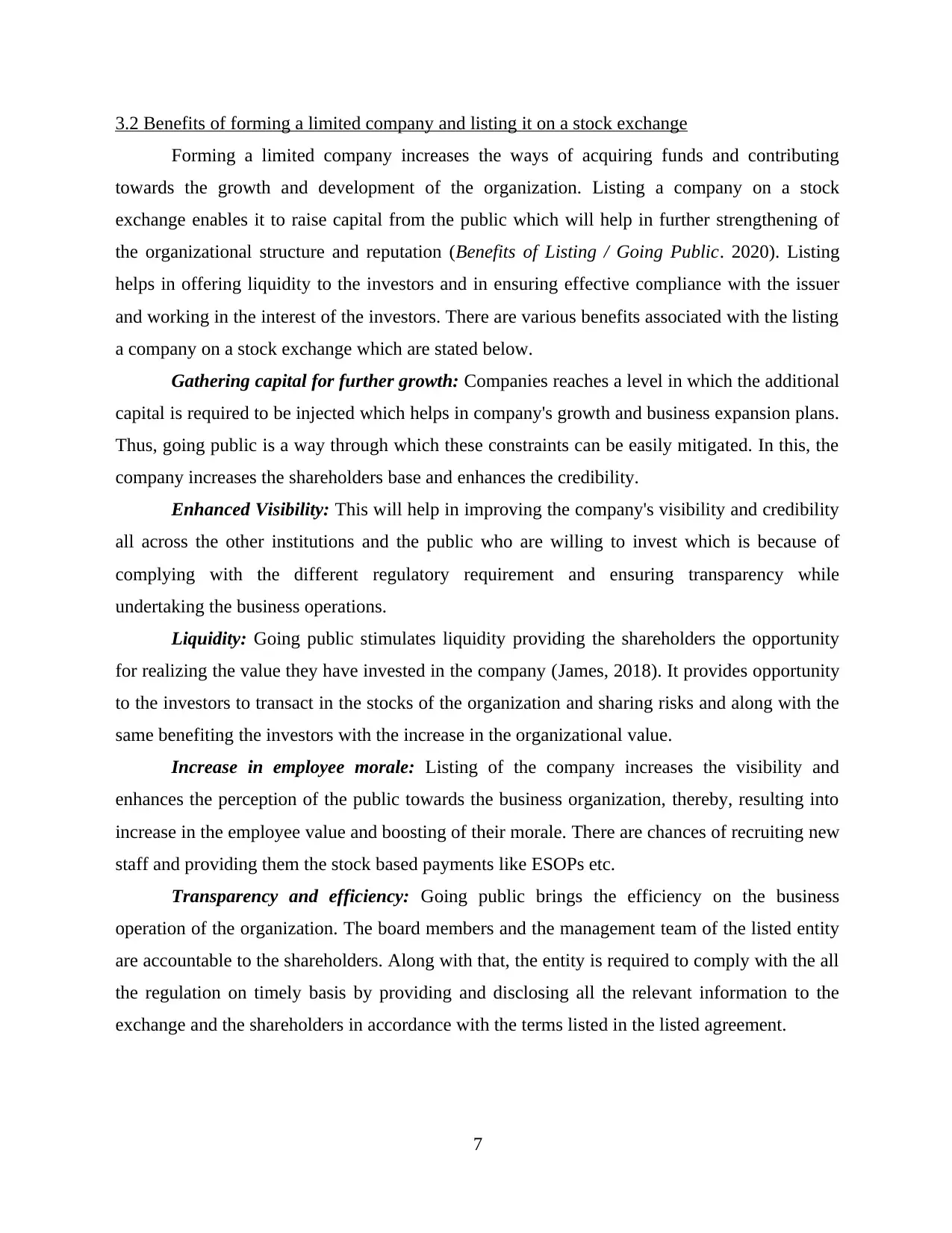
3.2 Benefits of forming a limited company and listing it on a stock exchange
Forming a limited company increases the ways of acquiring funds and contributing
towards the growth and development of the organization. Listing a company on a stock
exchange enables it to raise capital from the public which will help in further strengthening of
the organizational structure and reputation (Benefits of Listing / Going Public. 2020). Listing
helps in offering liquidity to the investors and in ensuring effective compliance with the issuer
and working in the interest of the investors. There are various benefits associated with the listing
a company on a stock exchange which are stated below.
Gathering capital for further growth: Companies reaches a level in which the additional
capital is required to be injected which helps in company's growth and business expansion plans.
Thus, going public is a way through which these constraints can be easily mitigated. In this, the
company increases the shareholders base and enhances the credibility.
Enhanced Visibility: This will help in improving the company's visibility and credibility
all across the other institutions and the public who are willing to invest which is because of
complying with the different regulatory requirement and ensuring transparency while
undertaking the business operations.
Liquidity: Going public stimulates liquidity providing the shareholders the opportunity
for realizing the value they have invested in the company (James, 2018). It provides opportunity
to the investors to transact in the stocks of the organization and sharing risks and along with the
same benefiting the investors with the increase in the organizational value.
Increase in employee morale: Listing of the company increases the visibility and
enhances the perception of the public towards the business organization, thereby, resulting into
increase in the employee value and boosting of their morale. There are chances of recruiting new
staff and providing them the stock based payments like ESOPs etc.
Transparency and efficiency: Going public brings the efficiency on the business
operation of the organization. The board members and the management team of the listed entity
are accountable to the shareholders. Along with that, the entity is required to comply with the all
the regulation on timely basis by providing and disclosing all the relevant information to the
exchange and the shareholders in accordance with the terms listed in the listed agreement.
7
Forming a limited company increases the ways of acquiring funds and contributing
towards the growth and development of the organization. Listing a company on a stock
exchange enables it to raise capital from the public which will help in further strengthening of
the organizational structure and reputation (Benefits of Listing / Going Public. 2020). Listing
helps in offering liquidity to the investors and in ensuring effective compliance with the issuer
and working in the interest of the investors. There are various benefits associated with the listing
a company on a stock exchange which are stated below.
Gathering capital for further growth: Companies reaches a level in which the additional
capital is required to be injected which helps in company's growth and business expansion plans.
Thus, going public is a way through which these constraints can be easily mitigated. In this, the
company increases the shareholders base and enhances the credibility.
Enhanced Visibility: This will help in improving the company's visibility and credibility
all across the other institutions and the public who are willing to invest which is because of
complying with the different regulatory requirement and ensuring transparency while
undertaking the business operations.
Liquidity: Going public stimulates liquidity providing the shareholders the opportunity
for realizing the value they have invested in the company (James, 2018). It provides opportunity
to the investors to transact in the stocks of the organization and sharing risks and along with the
same benefiting the investors with the increase in the organizational value.
Increase in employee morale: Listing of the company increases the visibility and
enhances the perception of the public towards the business organization, thereby, resulting into
increase in the employee value and boosting of their morale. There are chances of recruiting new
staff and providing them the stock based payments like ESOPs etc.
Transparency and efficiency: Going public brings the efficiency on the business
operation of the organization. The board members and the management team of the listed entity
are accountable to the shareholders. Along with that, the entity is required to comply with the all
the regulation on timely basis by providing and disclosing all the relevant information to the
exchange and the shareholders in accordance with the terms listed in the listed agreement.
7
⊘ This is a preview!⊘
Do you want full access?
Subscribe today to unlock all pages.

Trusted by 1+ million students worldwide
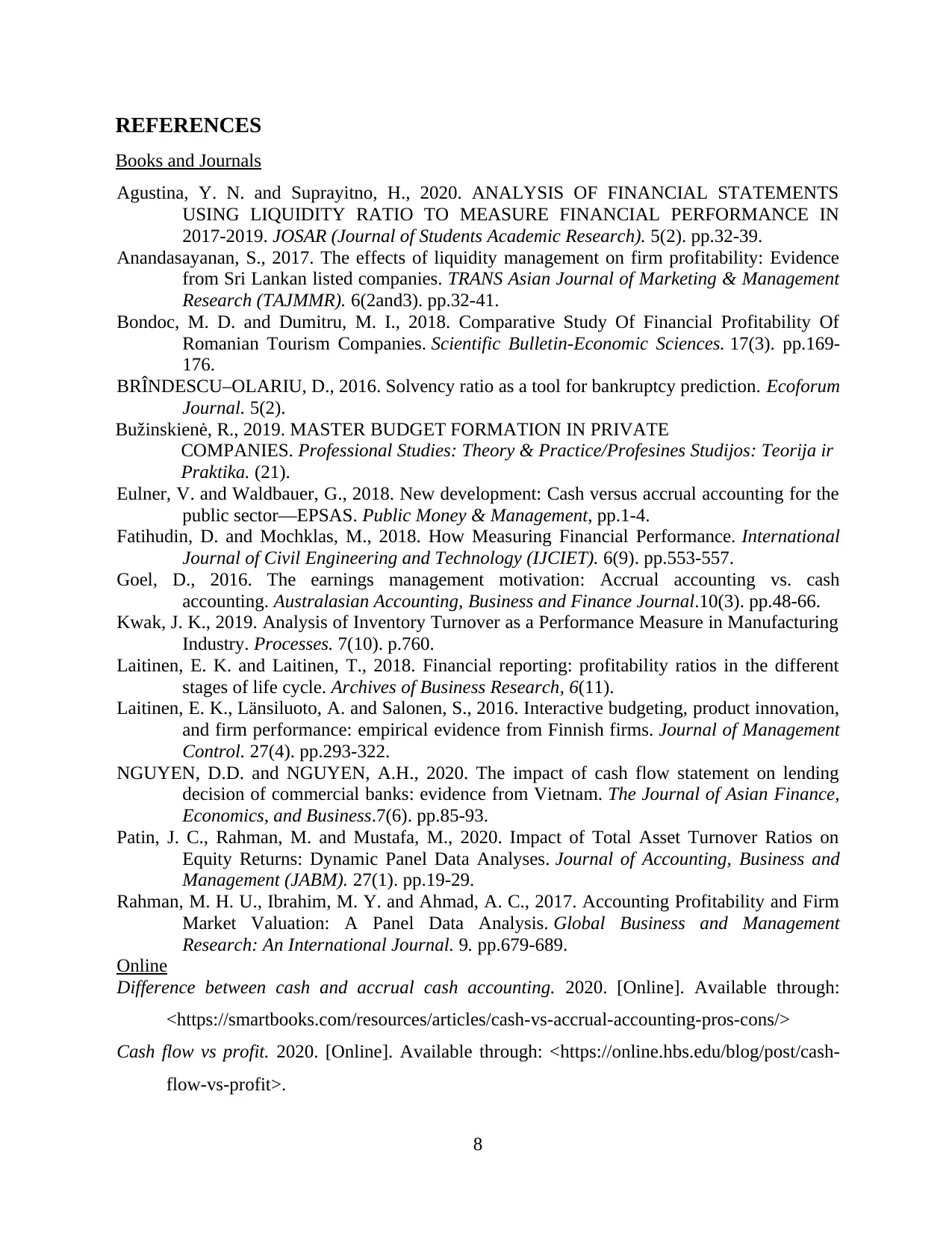
REFERENCES
Books and Journals
Agustina, Y. N. and Suprayitno, H., 2020. ANALYSIS OF FINANCIAL STATEMENTS
USING LIQUIDITY RATIO TO MEASURE FINANCIAL PERFORMANCE IN
2017-2019. JOSAR (Journal of Students Academic Research). 5(2). pp.32-39.
Anandasayanan, S., 2017. The effects of liquidity management on firm profitability: Evidence
from Sri Lankan listed companies. TRANS Asian Journal of Marketing & Management
Research (TAJMMR). 6(2and3). pp.32-41.
Bondoc, M. D. and Dumitru, M. I., 2018. Comparative Study Of Financial Profitability Of
Romanian Tourism Companies. Scientific Bulletin-Economic Sciences. 17(3). pp.169-
176.
BRÎNDESCU–OLARIU, D., 2016. Solvency ratio as a tool for bankruptcy prediction. Ecoforum
Journal. 5(2).
Bužinskienė, R., 2019. MASTER BUDGET FORMATION IN PRIVATE
COMPANIES. Professional Studies: Theory & Practice/Profesines Studijos: Teorija ir
Praktika. (21).
Eulner, V. and Waldbauer, G., 2018. New development: Cash versus accrual accounting for the
public sector—EPSAS. Public Money & Management, pp.1-4.
Fatihudin, D. and Mochklas, M., 2018. How Measuring Financial Performance. International
Journal of Civil Engineering and Technology (IJCIET). 6(9). pp.553-557.
Goel, D., 2016. The earnings management motivation: Accrual accounting vs. cash
accounting. Australasian Accounting, Business and Finance Journal.10(3). pp.48-66.
Kwak, J. K., 2019. Analysis of Inventory Turnover as a Performance Measure in Manufacturing
Industry. Processes. 7(10). p.760.
Laitinen, E. K. and Laitinen, T., 2018. Financial reporting: profitability ratios in the different
stages of life cycle. Archives of Business Research, 6(11).
Laitinen, E. K., Länsiluoto, A. and Salonen, S., 2016. Interactive budgeting, product innovation,
and firm performance: empirical evidence from Finnish firms. Journal of Management
Control. 27(4). pp.293-322.
NGUYEN, D.D. and NGUYEN, A.H., 2020. The impact of cash flow statement on lending
decision of commercial banks: evidence from Vietnam. The Journal of Asian Finance,
Economics, and Business.7(6). pp.85-93.
Patin, J. C., Rahman, M. and Mustafa, M., 2020. Impact of Total Asset Turnover Ratios on
Equity Returns: Dynamic Panel Data Analyses. Journal of Accounting, Business and
Management (JABM). 27(1). pp.19-29.
Rahman, M. H. U., Ibrahim, M. Y. and Ahmad, A. C., 2017. Accounting Profitability and Firm
Market Valuation: A Panel Data Analysis. Global Business and Management
Research: An International Journal. 9. pp.679-689.
Online
Difference between cash and accrual cash accounting. 2020. [Online]. Available through:
<https://smartbooks.com/resources/articles/cash-vs-accrual-accounting-pros-cons/>
Cash flow vs profit. 2020. [Online]. Available through: <https://online.hbs.edu/blog/post/cash-
flow-vs-profit>.
8
Books and Journals
Agustina, Y. N. and Suprayitno, H., 2020. ANALYSIS OF FINANCIAL STATEMENTS
USING LIQUIDITY RATIO TO MEASURE FINANCIAL PERFORMANCE IN
2017-2019. JOSAR (Journal of Students Academic Research). 5(2). pp.32-39.
Anandasayanan, S., 2017. The effects of liquidity management on firm profitability: Evidence
from Sri Lankan listed companies. TRANS Asian Journal of Marketing & Management
Research (TAJMMR). 6(2and3). pp.32-41.
Bondoc, M. D. and Dumitru, M. I., 2018. Comparative Study Of Financial Profitability Of
Romanian Tourism Companies. Scientific Bulletin-Economic Sciences. 17(3). pp.169-
176.
BRÎNDESCU–OLARIU, D., 2016. Solvency ratio as a tool for bankruptcy prediction. Ecoforum
Journal. 5(2).
Bužinskienė, R., 2019. MASTER BUDGET FORMATION IN PRIVATE
COMPANIES. Professional Studies: Theory & Practice/Profesines Studijos: Teorija ir
Praktika. (21).
Eulner, V. and Waldbauer, G., 2018. New development: Cash versus accrual accounting for the
public sector—EPSAS. Public Money & Management, pp.1-4.
Fatihudin, D. and Mochklas, M., 2018. How Measuring Financial Performance. International
Journal of Civil Engineering and Technology (IJCIET). 6(9). pp.553-557.
Goel, D., 2016. The earnings management motivation: Accrual accounting vs. cash
accounting. Australasian Accounting, Business and Finance Journal.10(3). pp.48-66.
Kwak, J. K., 2019. Analysis of Inventory Turnover as a Performance Measure in Manufacturing
Industry. Processes. 7(10). p.760.
Laitinen, E. K. and Laitinen, T., 2018. Financial reporting: profitability ratios in the different
stages of life cycle. Archives of Business Research, 6(11).
Laitinen, E. K., Länsiluoto, A. and Salonen, S., 2016. Interactive budgeting, product innovation,
and firm performance: empirical evidence from Finnish firms. Journal of Management
Control. 27(4). pp.293-322.
NGUYEN, D.D. and NGUYEN, A.H., 2020. The impact of cash flow statement on lending
decision of commercial banks: evidence from Vietnam. The Journal of Asian Finance,
Economics, and Business.7(6). pp.85-93.
Patin, J. C., Rahman, M. and Mustafa, M., 2020. Impact of Total Asset Turnover Ratios on
Equity Returns: Dynamic Panel Data Analyses. Journal of Accounting, Business and
Management (JABM). 27(1). pp.19-29.
Rahman, M. H. U., Ibrahim, M. Y. and Ahmad, A. C., 2017. Accounting Profitability and Firm
Market Valuation: A Panel Data Analysis. Global Business and Management
Research: An International Journal. 9. pp.679-689.
Online
Difference between cash and accrual cash accounting. 2020. [Online]. Available through:
<https://smartbooks.com/resources/articles/cash-vs-accrual-accounting-pros-cons/>
Cash flow vs profit. 2020. [Online]. Available through: <https://online.hbs.edu/blog/post/cash-
flow-vs-profit>.
8
Paraphrase This Document
Need a fresh take? Get an instant paraphrase of this document with our AI Paraphraser

Benefits of Listing / Going Public. 2020. [Online]. Available
Through:<https://www.msei.in/Corporates/benefits-of-listing>.
James, H., 2018. BENEFITS OF STOCK EXCHANGE FOR THE COMPANY. [Online].
Available Through:<https://www.omniamerican.com/benefits-of-stock-exchange-for-
the-company/>.
9
Through:<https://www.msei.in/Corporates/benefits-of-listing>.
James, H., 2018. BENEFITS OF STOCK EXCHANGE FOR THE COMPANY. [Online].
Available Through:<https://www.omniamerican.com/benefits-of-stock-exchange-for-
the-company/>.
9
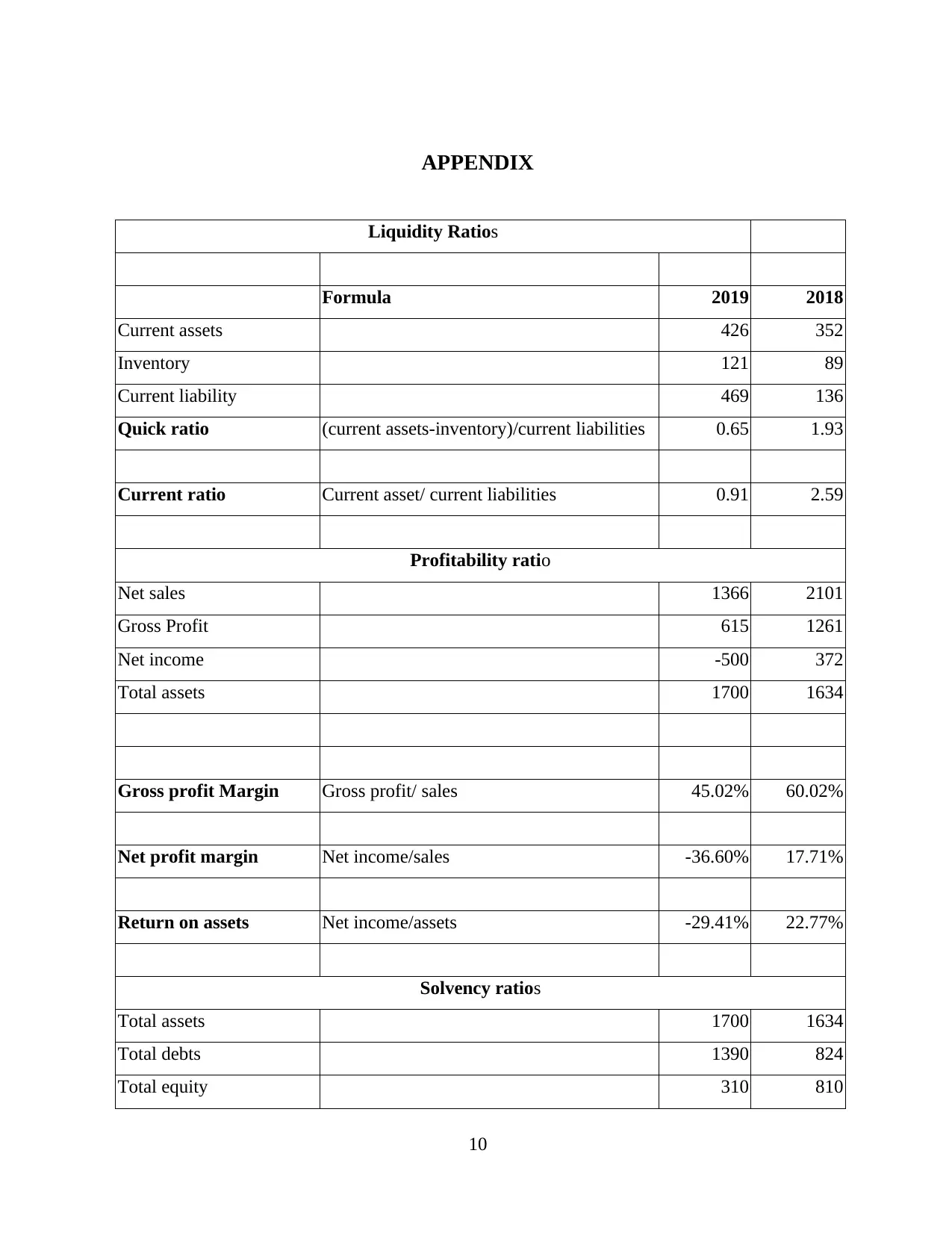
APPENDIX
Liquidity Ratios
Formula 2019 2018
Current assets 426 352
Inventory 121 89
Current liability 469 136
Quick ratio (current assets-inventory)/current liabilities 0.65 1.93
Current ratio Current asset/ current liabilities 0.91 2.59
Profitability ratio
Net sales 1366 2101
Gross Profit 615 1261
Net income -500 372
Total assets 1700 1634
Gross profit Margin Gross profit/ sales 45.02% 60.02%
Net profit margin Net income/sales -36.60% 17.71%
Return on assets Net income/assets -29.41% 22.77%
Solvency ratios
Total assets 1700 1634
Total debts 1390 824
Total equity 310 810
10
Liquidity Ratios
Formula 2019 2018
Current assets 426 352
Inventory 121 89
Current liability 469 136
Quick ratio (current assets-inventory)/current liabilities 0.65 1.93
Current ratio Current asset/ current liabilities 0.91 2.59
Profitability ratio
Net sales 1366 2101
Gross Profit 615 1261
Net income -500 372
Total assets 1700 1634
Gross profit Margin Gross profit/ sales 45.02% 60.02%
Net profit margin Net income/sales -36.60% 17.71%
Return on assets Net income/assets -29.41% 22.77%
Solvency ratios
Total assets 1700 1634
Total debts 1390 824
Total equity 310 810
10
⊘ This is a preview!⊘
Do you want full access?
Subscribe today to unlock all pages.

Trusted by 1+ million students worldwide
1 out of 13
Related Documents
Your All-in-One AI-Powered Toolkit for Academic Success.
+13062052269
info@desklib.com
Available 24*7 on WhatsApp / Email
![[object Object]](/_next/static/media/star-bottom.7253800d.svg)
Unlock your academic potential
Copyright © 2020–2025 A2Z Services. All Rights Reserved. Developed and managed by ZUCOL.





